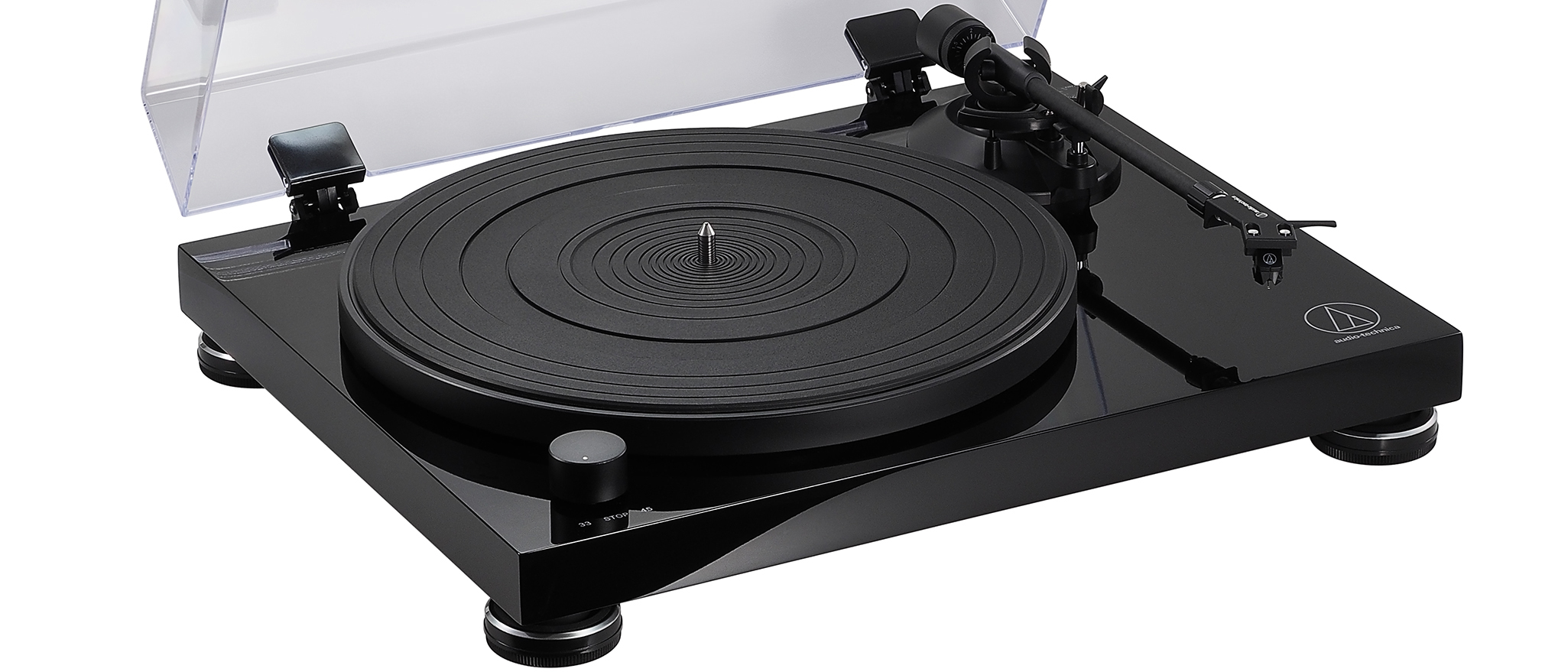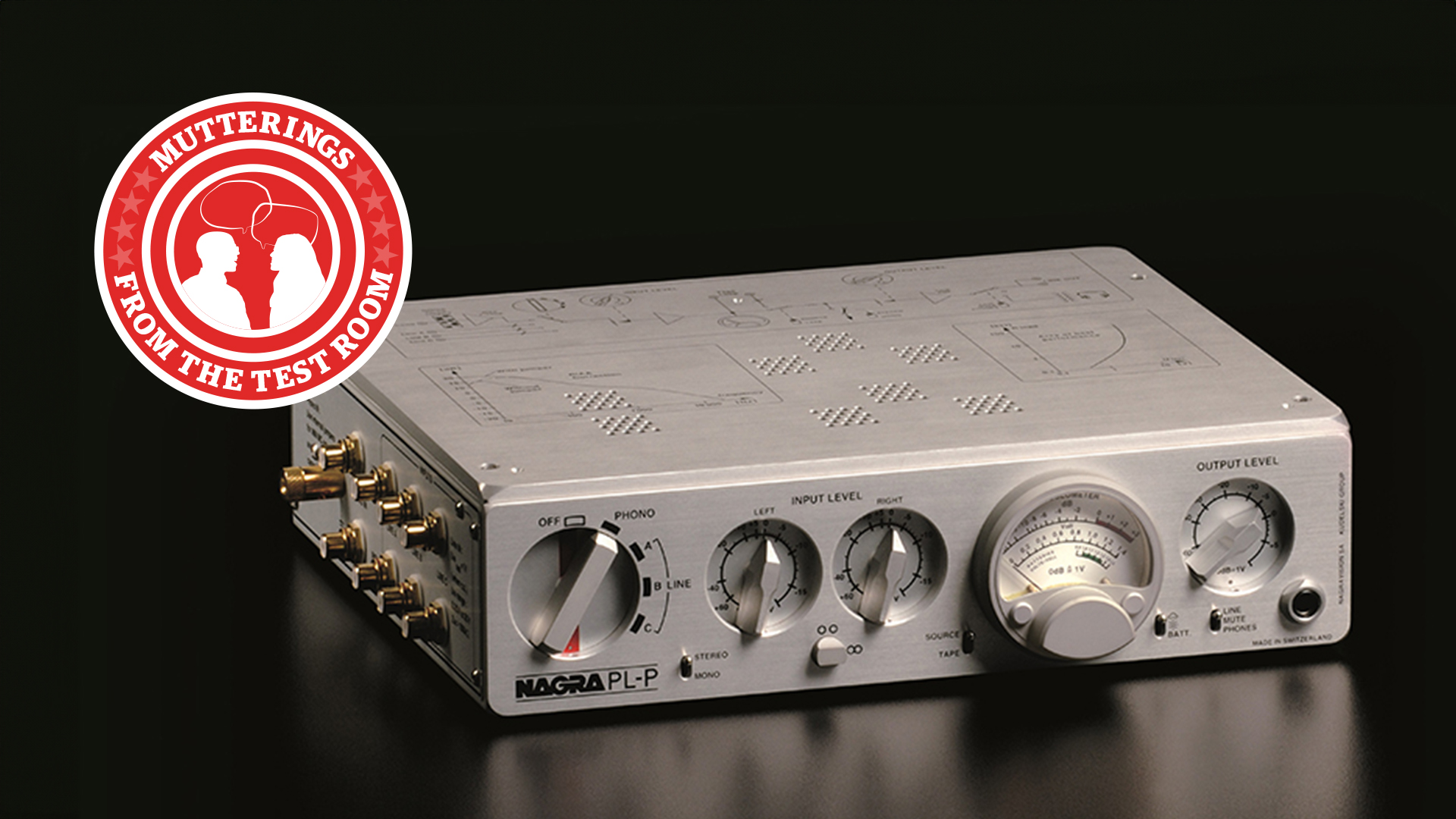What Hi-Fi? Verdict
This turntable dazzles with its stylish and svelte design, excellent sound quality, solid included phono cartridge and, perhaps most impressively, the affordable price at which it's all delivered.
Pros
- +
Fantastic looks
- +
Built in phono stage
- +
Sound quality
Cons
- -
RCA terminals
Why you can trust What Hi-Fi?
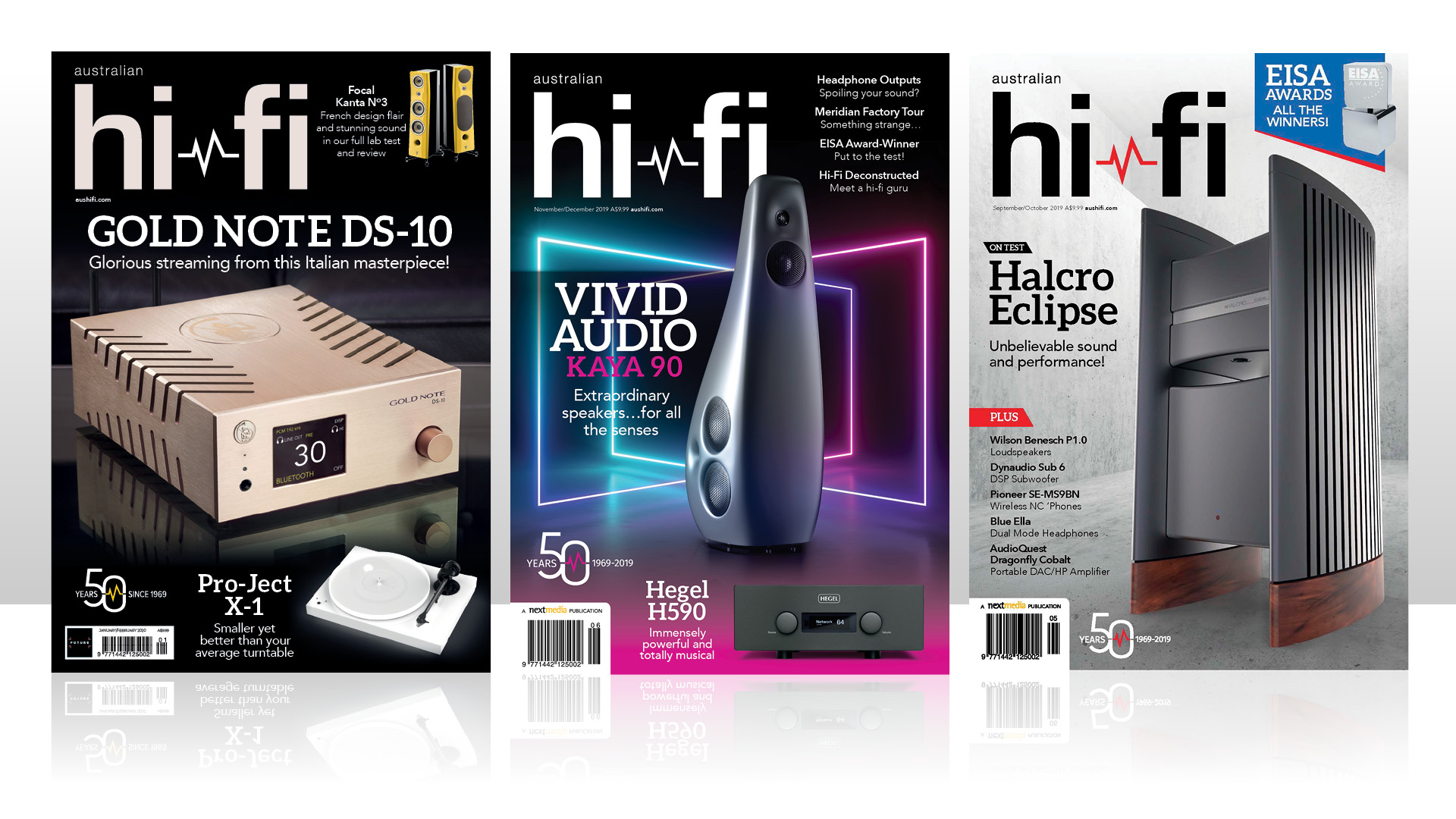
This review and test originally appeared in Australian Hi-Fi magazine, one of What Hi-Fi?’s sister titles from Down Under. Click here for more information about Australian Hi-Fi, including links to buy individual digital editions and details on how to subscribe.
It is said that good things come to those who wait, and it’s a good thing that Audio-Technica’s AT-LPW50PB turntable is finally available in Australia, because I have been anticipating its arrival since its launch in the USA at CES 2020 – a show that, due to Covid-19, was a ‘virtual’ event, so that it was not possible for me to see or hear it in the flesh.
My anticipation was partly because of Audio-Technica’s unrivalled reputation in the field of all things vinyl, particularly phono cartridges, but more recently, turntables. This famous Japanese company has been in the business for more than half-a-century, after all.
But it was also because with the AT-LPW50PB, Audio-Technica has finally released a turntable in my wife’s preferred finish (piano black), that’s also a turntable that’s a no-frills, belt-driven model that has been designed for out-and-out performance with vinyl. So I don’t have to pay for a USB output (which I don’t want) nor do I have to pay for Bluetooth connectivity (which I also don’t want).
OK, so it does come with an in-built phono stage, which I personally do not need, being the owner of several external phono stages, both active and passive, as well as owning two amplifiers with phono stages already built in, but I guess that I am not Audio-Technica’s typical customer, and that the company has figured out that most of the people catching the wave that is the vinyl resurgence would rather have the convenience of an in-built phono stage, so that they can connect it to, well, pretty much any type of component that has a line-level input, be it an amplifier or a powered loudspeaker.
Features
The first thing I have to say about the new Audio-Technica AT-LPW50PB is that it is simply gorgeous! If we were to go on looks alone, there isn’t a single turntable for sale for under AU$1,000 that looks anywhere near as good as the LPW50PB. Indeed it looks a whole lot like Yamaha’s GT-5000 and that unit will set you back the best part of AU$13,000!
But important though looks might be, it is performance that counts, and when you look how the AT-LPW50PB is put together, you will quickly gain the impression that it’s built in such a way that it will be able to deliver very high performance indeed.
Let’s take the plinth for a start. It not only looks good, it is also very solidly built, at 30mm thick. And there’s a good chunk of wood involved in building it, not some flimsy bit of plastic. Indeed most of the turntable’s not insubstantial weight (5.5kg) is due to the plinth. A good solid plinth means less resonance and improved resistance to airborne vibration, which is exactly what you want in a turntable. The plinth is supported by four feet that are slightly flexible, but not ‘springy’ as such.
The AT-LPW50PB has two speeds on tap – 33.33 and 45 rpm – selected via the rotary switch at the front left of the plinth. Although the switch has a central ‘Off’ position, this simply stops platter rotation. To switch the turntable off you need to access a small press-button that is rather inconveniently located at the rear of the turntable.

This press-button is a low-voltage switch because power for the Audio-Technica AT-LPW50PB is supplied by a switch-mode power supply plug-pack that plugs into a 240V power socket and it’s this that provides the 12-volts of direct current the turntable’s motor requires. Although the plug-pack is branded ‘Audio-Technica’ it is actually made by a company going by the name of Golden Profit Electronics.
As mentioned in the introduction to this review, the Audio-Technica AT-LPW50PB has a phono pre-amplifier built in, the output of which is at the rear of the turntable.
I was pleasantly surprised to discover that you don’t have to use it if you don’t want to, because there’s a slider switch alongside the two gold-plated RCA outputs that allows you to take the output directly from the cartridge and send it to your own external phono preamplifier if you’d prefer.
These two gold-plated RCA outputs have a diameter that is very slightly smaller than standard, so using standard RCA plugs results in a rather ‘loose’ fit and a tenuous electrical connection. You can fix this by squeezing in the outer (negative) ring of the plugs on the cable before you use them.
The Audio-Technica AT-LPW50PB’s lightweight aluminium platter comes standard with a rubber mat, but you can optionally purchase one that’s made from anti-static fibre. The two mats have different thicknesses, which mean you will be able to adjust the vertical tracking angle of the cartridge using the mats. Audio-Technica’s Australian distributor, Technical Audio Group, kindly included the anti-static fibre mat with my review sample.
The Audio-Technica AT-LPW50PB comes with a clear Perspex dustcover and spring-loaded hinges. It’s nice that these are provided standard, rather than as an optional extra. The spring-loading of the hinges means that if you give the lid a slight push when you first lift it, it will rise automatically to the fully open position without further input from you.
The spring loading also prevents the cover from dropping too quickly. You need to manually close the lid at least to the 45° position, after which it will descend fairly gracefully by itself until it comes to a stop on small rubber stoppers (which are attached to the cover, not the turntable).
Tonearm
The tonearm is a straight-line carbon-fibre, statically-balanced type with spring-applied anti-skating. It’s fitted with a universal headshell mount which makes it a snack to swap headshells fitted with different phono cartridges.
The counterweight is the standard type, with a separate ring to indicate down-force. I first used this to apply the recommended down-force for the cartridge (2.0 grams) and then checked the down-force with a digital stylus gauge, which showed down-force at 2.1 grams, proving that you’ll be able to accurately adjust down-force even without a separate gauge. The spring-loaded anti-skating force is applied by a small rotary dial at the base of the tonearm mount.
The design of the AT-LPW50PB’s tonearm pivot makes it difficult to use cartridge alignment protractors that depend on you finding the centre of the pivot from above (for example the alignment gauges made by Feickert or Brinkmann) so you’d be better to use one that uses sighting lines, such as the Mo-Fi Geo-Disc.
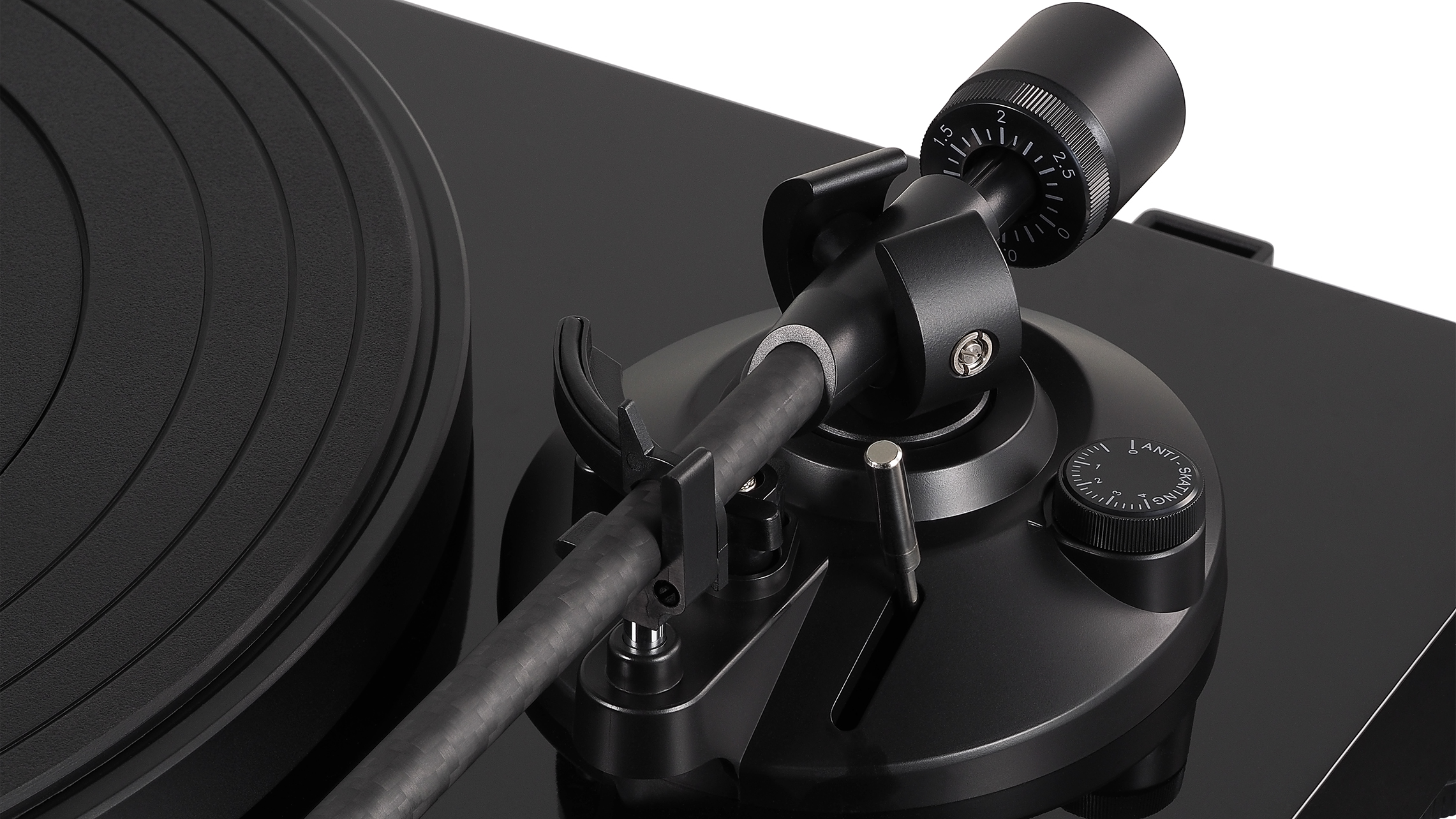
However, when I checked the alignment of the AT-VM95E cartridge that’s supplied pre-installed in Audio-Technica’s upgraded AT-HS4 universal-mount headshell I was pleasantly surprised to find that it had been perfectly aligned at the factory, so if you don’t ever replace the cartridge, you won’t need to invest in an alignment tool. (Actually, I would not expect that you would have to invest in one anyway — hi-fi retailers should provide this alignment as a free service.)
The cartridge fitted to the end of this tonearm is, of course, made by Audio-Technica itself and is included in the price of the turntable. It’s an AT-VM95E moving-magnet cartridge with an elliptical stylus. This particular design has quite an interesting back-story because although it was released only about two years ago, it is really an evolution of (and the replacement for) Audio-Technica’s AT-95E cartridge, a model that had been in continuous production for almost 40 years as a part of the ‘95’ series, about which more in a moment.
AT-M95 phono cartridge
The new AT-VM95 Series cartridges all feature the same dual-magnet design which, according to Audio-Technica “duplicates the ‘V’-shaped arrangement of the magnets in the cutter-head [of the recording lathe] and precisely positions the magnets to match the positions of the left and right channels in the groove walls.”
The primary technical difference between the new AT-VM95 Series and the older AT-95 Series is that the new cartridges have newly-designed aluminium cantilevers and re-designed coils. Together, these two improvements have enabled increased output voltage, so output voltage is now 4mV, up from 3.5mV (measured at 1kHz for a recorded velocity of 5cm per second.)
However if you get the opportunity to see the two models side by side, you’ll see a great many cosmetic changes. The body of the cartridge has been completely redesigned, and is now the ‘modern’ shape that’s used by most manufacturers of moving-magnet cartridges. The removable stylus has a new ‘slider’ that makes it easier to remove and replace, and there’s a centring guide to help you do this.
The new model is also much easier to install and align than the older one, because whereas with the original AT-95 you had to fiddle around with bolts, nuts and washers, the new AT-VM95 has threaded brass sockets moulded into the cartridge body, so all you have to do is insert and tighten two screws.
The only slight hiccup that might affect installation is that Audio-Technica is using a 2.6mm Löwenherz thread which is a precision thread developed in Germany, rather than the standard 2.5mm metric thread, so you’ll need to use screws provided by Audio-Technica. However, since the AT-LP50PB comes with an AT-VM95E already installed, this is a moot point.
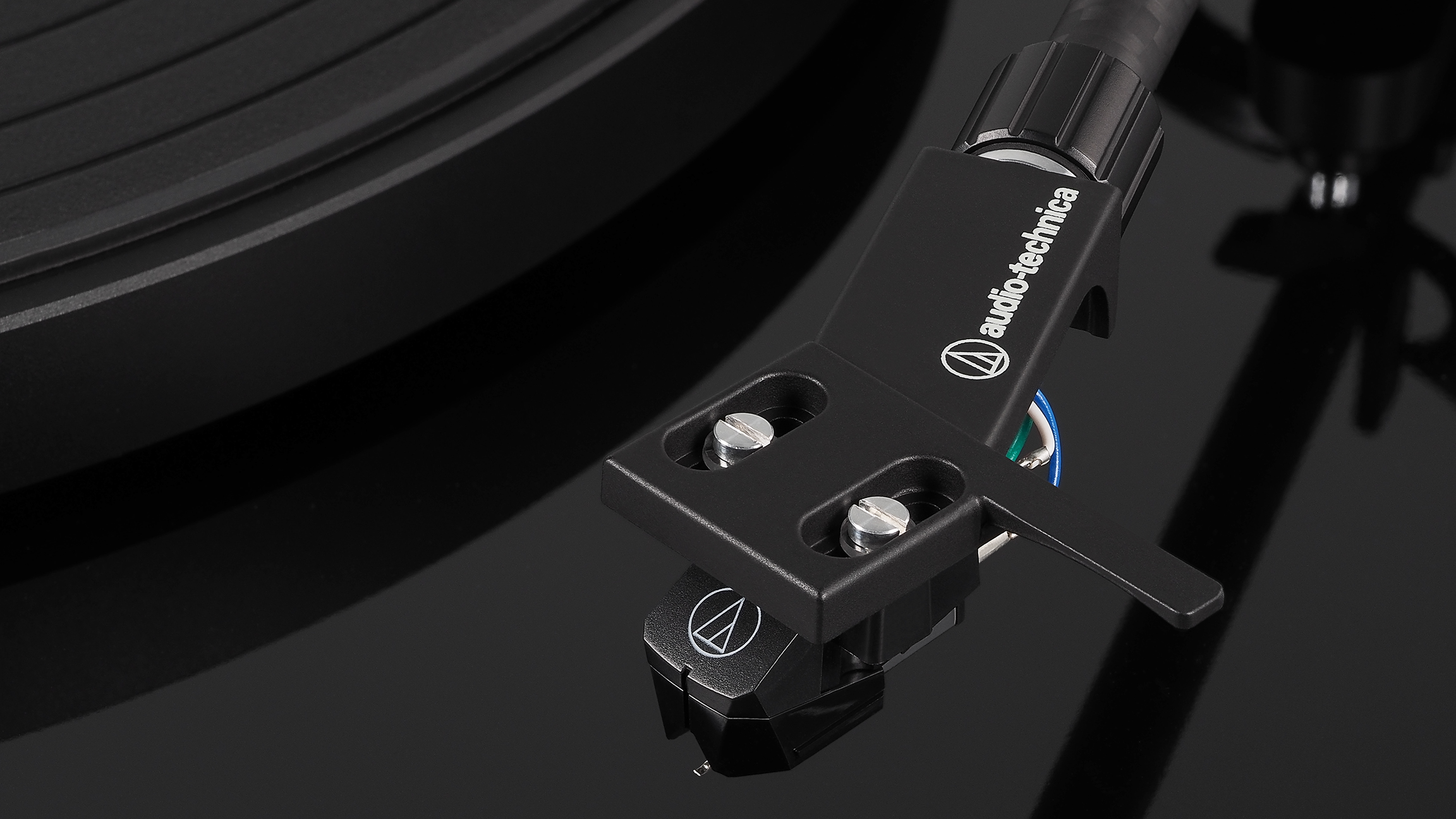
One thing that has not changed is that the stylus of the AT-VM95 Series cartridges is not only removable, but you can also use different diamond profiles. Audio-Technica makes replacement styluses with conical diamonds (VNM95C), elliptical diamonds (VNM95E), nude-mounted elliptical diamonds (VNM95EN), nude-mounted microline diamonds (VNM95ML) and a diamond with a line contact Shibata stylus (VNM95SH). This last profile was originally developed for the four-channel LPs that made a brief appearance in the late 70s, but many audiophiles prefer the sound of its extended high-frequency response.
Every one of these different styluses slides into the standard AT-VM95 cartridge body. But the esoteric diamond shapes come at a price. Whereas the VNM95C and VNM95E replacement styluses retail for less than £27 / $37 / AU$50, a VNM95EN retails for around £104 / $144 / AU$199, a VNM95ML for around £130 / $180 / AU$279 and a VNM95SH for around £158 / $220 / AU$299. This makes it a no-brainer to reserve your MicroLine stylus for use on pristine LPs that are clean and have no scratches and reserve your standard conical or elliptical stylus for use with vinyl that’s seen better days.
If those prices I have listed for the conical and elliptical replacement styluses seem rather low, this is because the price of a complete AT-VM95E cartridge itself – including the stylus – is just £50 / $70 / A$80, which is something of a bargain in today’s market.
Listening
The Audio-Technica AT-LPW50PB was super-easy to set up, primarily because there is so little to do. The rubber drive belt comes already fitted to the under-surface of the platter, so there’s none the usual ‘belt-wrapping fiddle’ associated with belt-drive turntables. And, as stated earlier, the cartridge is already fitted and aligned in the headshell, so all you need to do here is plug the headshell into the tonearm, fit the counterweight and then balance the arm and set the anti-skating.
You can choose to fit the dust-cover or not, but I would advise it, because your LPs will stay cleaner and the arm and cartridge will be completely protected whenever the lid is closed.
The most important task of any turntable is to rotate any LP you place on it at the correct speed and, since most LPs are recorded at 33.33 rpm, I think this is more important than the 45 rpm speed, so this is what I looked at most closely. My strobe disc (and associated strobe light) told me that the AT-LPW50PB’s platter was rotating just very slightly under the correct speed at 33.33 rpm and, when I checked 45 rpm, the same was true for this speed as well.
However, it was only very, very, slightly slow. Instead of the strobe marks being stationary, they were edging backwards ever so slowly. So slowly, as a matter of fact, that I guessed that correct musical pitch would not be affected. My guess proved to be correct because when I then checked for musical accuracy by using one of my ‘test’ LPs that has a 440Hz tone recorded on it and played the corresponding note “A” above middle C on my piano, which also has a frequency of 440Hz, to my ear, they were perfectly in tune.
So because rotational speed was musically accurate, I then decided to check for wow and flutter, for which slow piano music is the best to reveal if either or both are present, and one of the best slow piano works I know of is Erik Satie’s Gymnopédies. There are literally dozens of LPs you could use, as it has been recorded by far more than that number of well-known pianists.
It’s also a piece that’s played by almost every amateur pianist on the planet because of all the most well-known piano pieces, it seems to be the easiest to play because if you look at the score, you’ll see it’s almost blank, with some spaced-out chords that don’t require much of a finger-stretch and then only crotchets everywhere else — there’s not a quaver to be seen, much less a hemidemisemiquaver. But when you try to play it… wow! It’s so difficult to make it flow.
One of my favourite recordings was recorded by Dutch pianist Jeroen Van Veen in two different versions, both of which are on a double-LP set pressed by Brilliant Classics titled ‘Erik Satie Slow Music: Gymnopedies, Gnossiennes, And Other Works.’ Van Veen achieves a sublime perfection that eludes most pianists. I suspect his success might be because he’s not only also a composer but is also considered by many experts to be one of the leading exponents of minimalism in the world today. These traits, along with him being a great pianist, are obviously what’s required to make the music work!
On this album van Veen stretches the concept of slowness to the extreme. One critic wrote of it that: “he creates an hallucinatory effect, a kind of minimal music avant la lettre.”
I don’t know if that’s strictly true, but despite his incredibly slow tempi, I could not perceive any wow and flutter from the Audio-Technica AT-LPW50PB at all… not a skerrick. And if I couldn’t hear it with this performance, it will never become audible at all, with any type of music.
The same album is also excellent for evaluating the contributions from background noise which, for a turntable, will always be rumble caused by either the motor or the platter bearing… or both. Despite the quietness of the music and the silences between the notes, and the high quality of the pressing, I could not hear any rumble at all, so for me the AT-LPW50PB has a clean slate in this department as well.
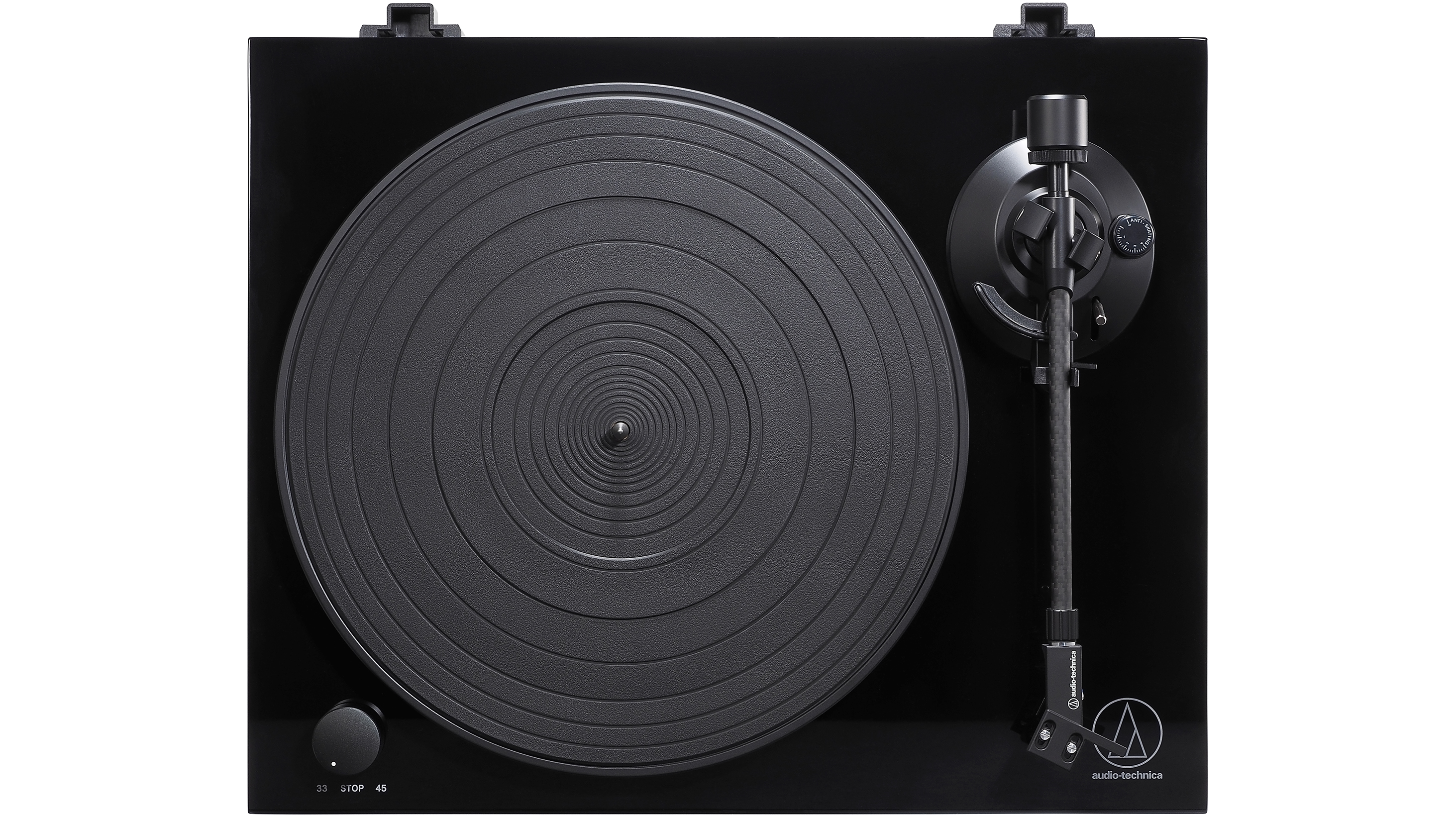
So far as the sound of the Audio-Technica AT-VM95E cartridge is concerned, it’s immediately obvious why it has been one of the world’s best-selling models for almost four decades! (In fact, a prestigious UK identified it as “one of the best-selling cartridges of all time”). It has a smooth, rich sound quality that makes for very easy and very enjoyable listening, particularly on well-worn records, where there seemed to be less high-frequency noise than I heard when listening to the same recording using one of my moving-coil cartridges (in my own arm and turntable, not the Audio-Technica, but both played A–B style through the same amplifier and loudspeakers).
I found that the Audio-Technica AT-VM95E not only sounds very good but also tracks very well, and coped nicely with all the music LPs I use to test tracking, as well as performing decently on my Shure Trackability Test Record.
But then it was back to music music and Neil Young’s wonderful ‘Harvest’ particularly its most inappropriately-named track, Needle and the Damage Done, because the AT-VM95E tracks so beautifully that it will do your albums no harm at all.
The songs on this particular album, such as that one, plus the title track, Heart of Gold, Alabama, and Old Man… are all amongst Young’s finest songs but of course if you were going for Olympics-style placings, that would be Helpless, After the Goldrush and Only Love Can Break Your Heart.
The Audio-Technica AT-VM95E delivered all the songs on ‘Harvest’ smoothly, fluidly and very musically, and you can’t really ask for much more than that.
Playing back Mary J. Blige’s No Drama also saw the Audio-Technica combo turning in a cohesive and musical performance with a surefooted and robust presentation that remained unflustered even as the song became more demanding. I was hearing plenty of fine detail and the music was rendered with a lovely composure, though this was perhaps partly because it was just a little toned-down in the extreme highs.
Deciding to test the AT-VM95E’s ability to deliver fine music whilst also having the cartridge track at the extremes saw me spin up Beethoven’s Fifth and it did a fine job rendering the scale and power of this mighty symphony. The extraordinary dynamics were delivered fluidly, yet with the appropriate force and the resolution was such that I could follow subtle instrumental strands even during the most climactic moments.
I was particularly impressed by the stereo image the Audio-Technica cartridge was able to deliver in my listening room; it was so precise I was able to easily identify the position of instruments anywhere across the sound stage.
Final verdict
Oddly enough, given that I am a hi-fi reviewer and should have given some prior thought to such things, I have never really thought about whether there is a ‘sweet spot’ in terms of price when it comes to matching a cartridge with a turntable, even though I kind of do this as a matter of course when it comes to amplifiers, loudspeakers and source components.
I imagine that Audio-Technica has given the topic some thought and if it has applied that thinking to the review product, it would appear the company seems to think that a ratio of about 6:1 is about right, so if you spend AU$600 on a turntable, you should be spending around AU$100 on the cartridge. Or, to put it another way, for every dollar you spend on your cartridge, you should spend six dollars on your turntable.
That formula certainly works for me, though I think that I would personally stretch it out to 6:2 so the formula would enable me to buy my favourite budget cartridge, the Ortofon 2M Red. But actually, since I’d already be getting an AT-VM95E free with the AT-LPW50B, I’d get a 2M Red anyway as a second cartridge.
Audio-Technica’s AT-LPW50B is an excellent, good-looking and well-priced turntable that I am very happy to recommend, just as I am very happy to recommend you use the AT-VM95E cartridge in it, not only for its sound quality and tracking ability, but also because of the availability of different diamond stylus profiles and the very low cost of replacement styluses.
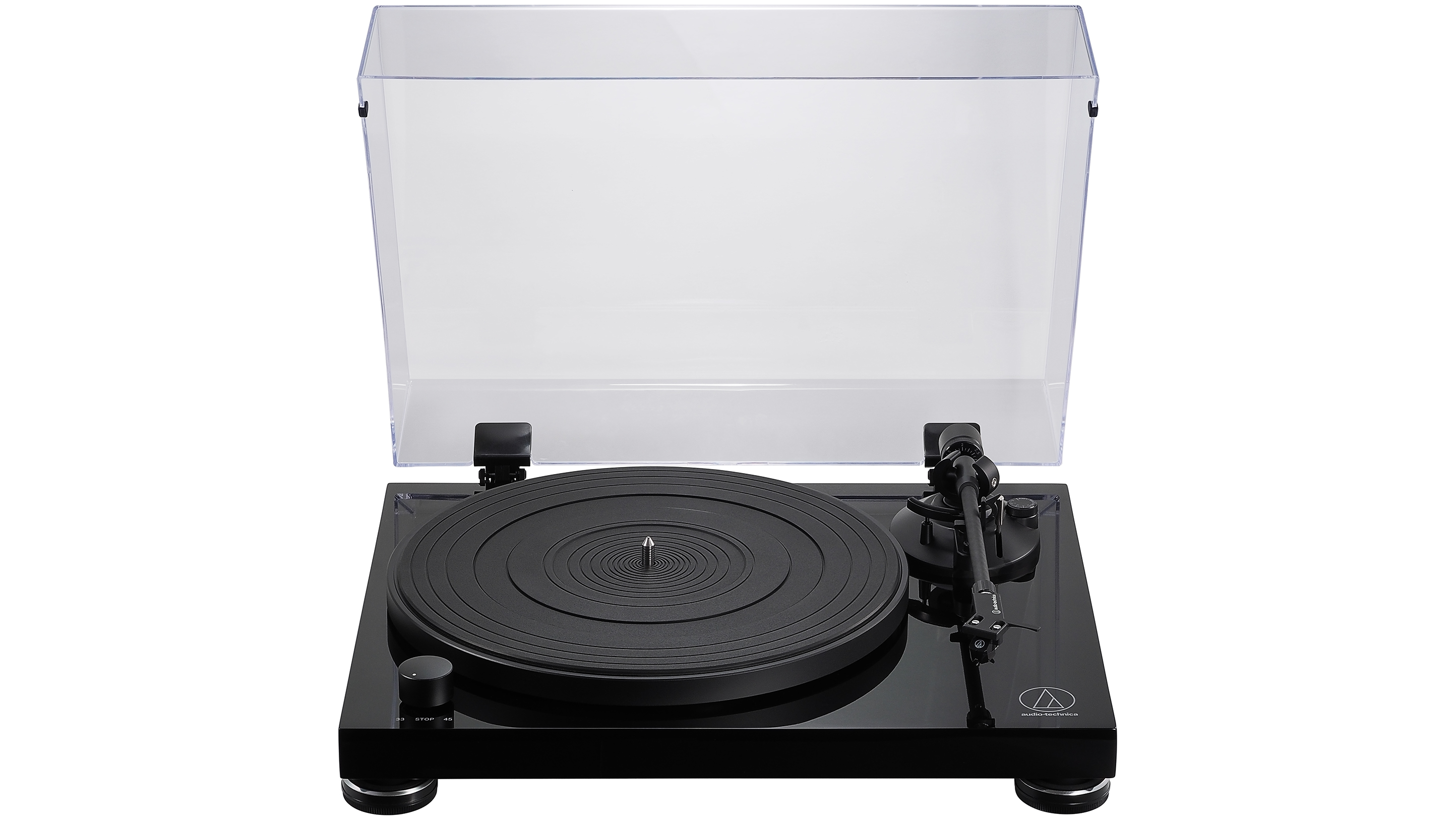
Full lab test results
Newport Test Labs first tested the speed stability of the AT-LPW50PB’s platter rotation and found it to be extremely stable at both fitted speeds. Tested with a 3kHz signal at 33.33 rpm, the speed of the Audio-Technica AT-LPW50B varied such that the frequency of the test signal was measured as varying only between 2997Hz and 3000Hz, with wow accounting for the minuscule 3Hz variance, though one also has to factor in that the test record itself would have some inherent wow.
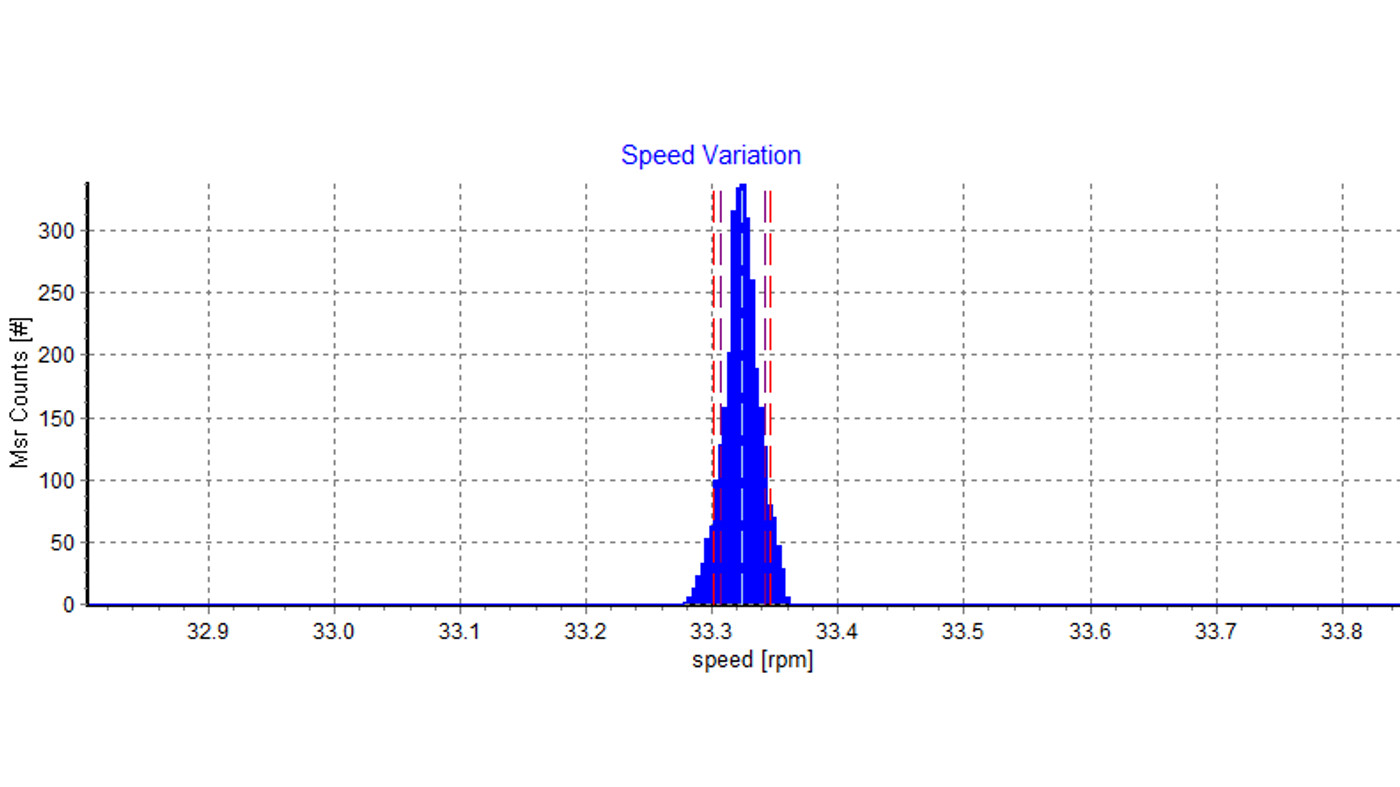
Measured at 45 rpm, the AT-LPW50B’s platter speed was even more stable, so that the measured frequency varied only between 2998Hz and 3000Hz. Again, this is an excellent result. Newport Test Labs has plotted these variations in the speed histogram (Graph 1).
The light blue dashed vertical line at the centre shows the mean actual speed, which you can see is very slightly lower than 33.33 rpm at 33.324 rpm, so 0.006 rpm slow. Not significant. The purple and red dashed vertical lines show the wow measured according to DIN IEC 386 using both the dynamic method (purple dashes) and the 2 sigma method (red dashes). In terms of percentages, the measured wow using the DIN IEC 386 2 sigma method was 0.08% at 33.33 rpm and 0.07% at 45 rpm.
Flutter was measured separately for both speeds, again using both CCIR and DIN measurement techniques. At 33.33 rpm Newport Test Labs measured flutter at 0.05% (CCIR) and 0.045% (DIN). At 45 rpm, flutter was measured at 0.055% (CCIR) and 0.05% (DIN).
Newport Test Labs also measured combined wow and flutter (W&F) for three different standards — CCIR-weighted, DIN-weighted and RMS unweighted. At 33.33 rpm the AT-LPW50B returned the following results — 0.045% (CCIR), 0.065% (DIN) and 0.05% (RMS). At 45 rpm the measured wow and flutter figures were 0.07% (CCIR), 0.07% (DIN) and 0.05% (RMS).
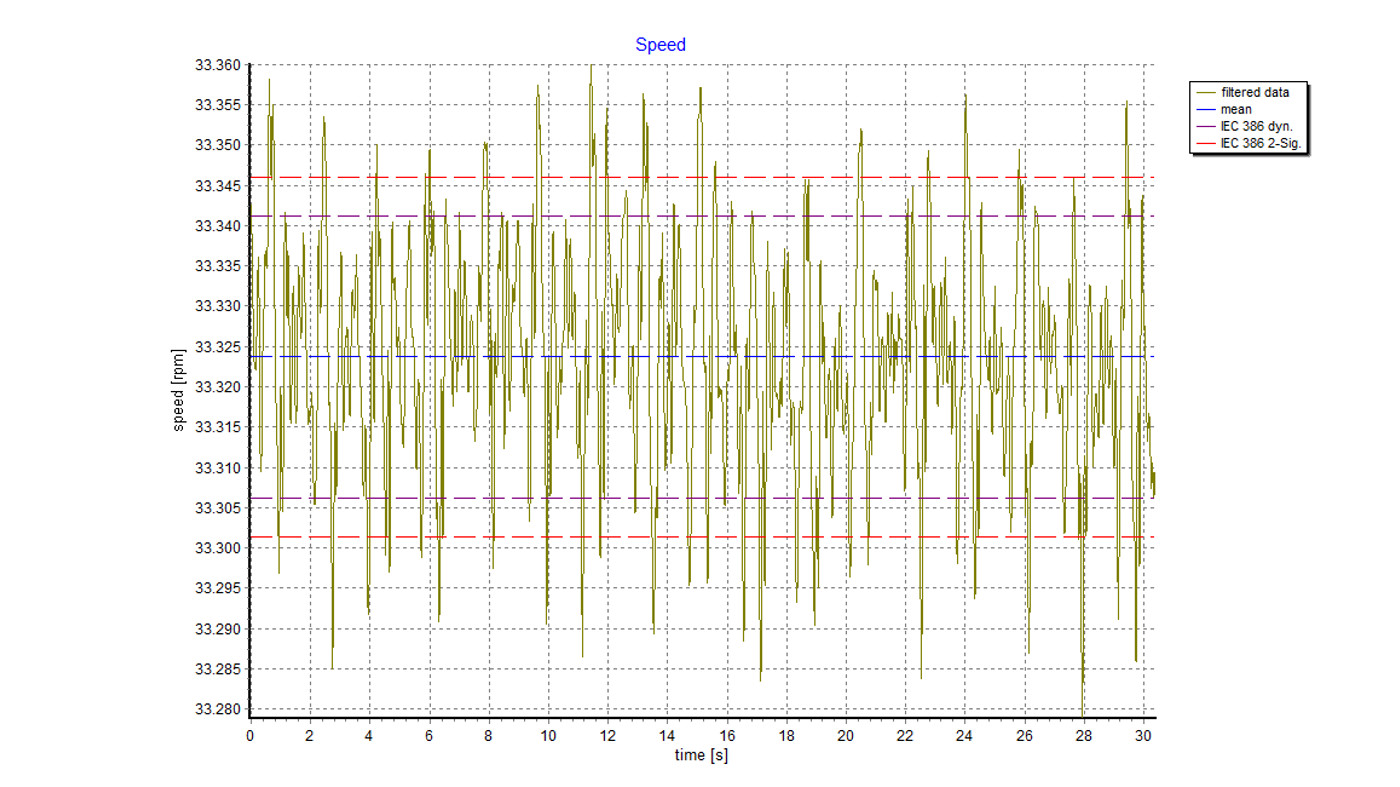
Wow and flutter results have been plotted graphically in Graph 2 over a period of 30 seconds. As in Graph 1, you can see the average according to DIN IEC 386 using the dynamic method (purple dashes) and the 2 sigma method (red dashes).
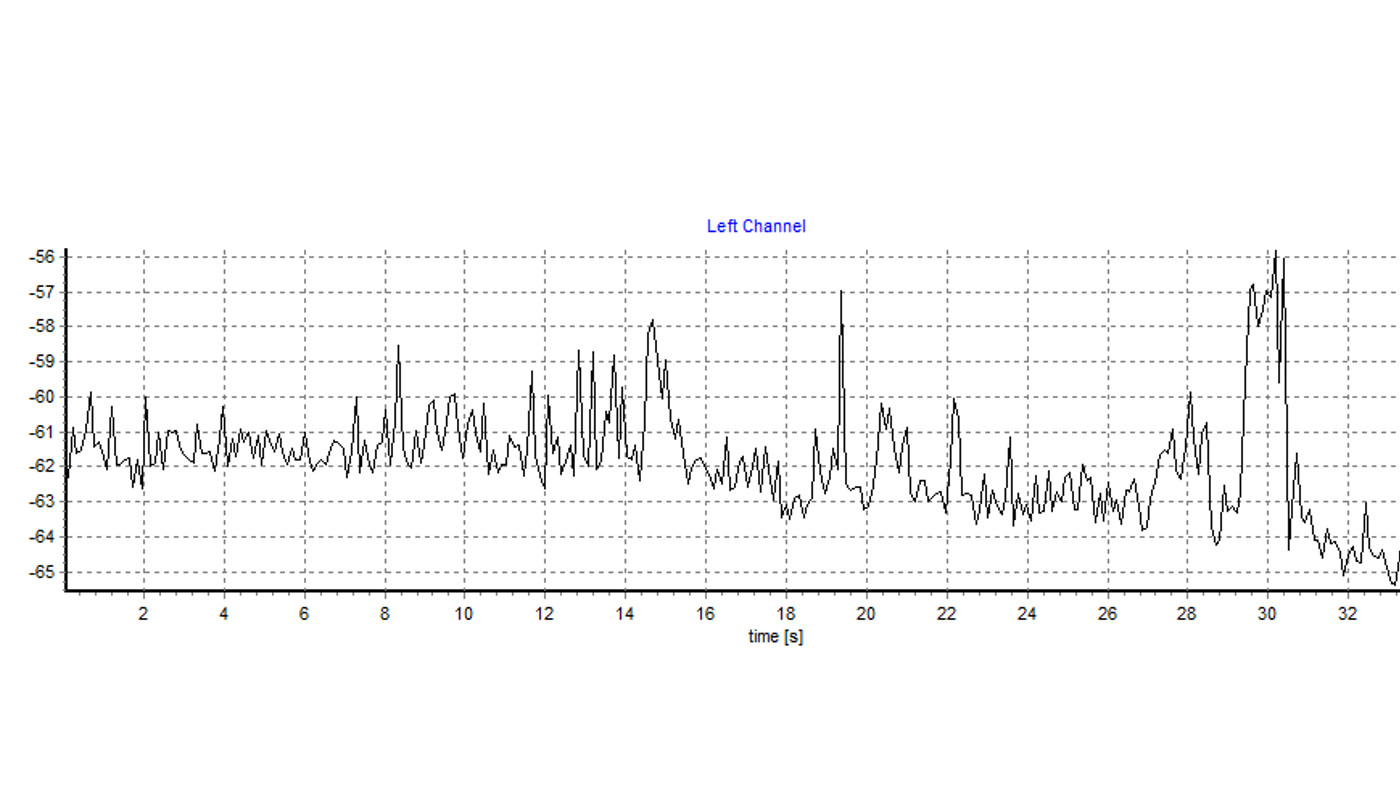
Rumble was handily more than 60dB down and so better than specification, as shown in Graph 3 which shows the rumble as measured over a duration of around 35 seconds.
You should ignore the spikes in the trace at around 15, 19.5 and 30 seconds as these were the result of external environmental noises, which are almost impossible to eliminate in a rumble measurement, due to the very nature of what’s being measured.
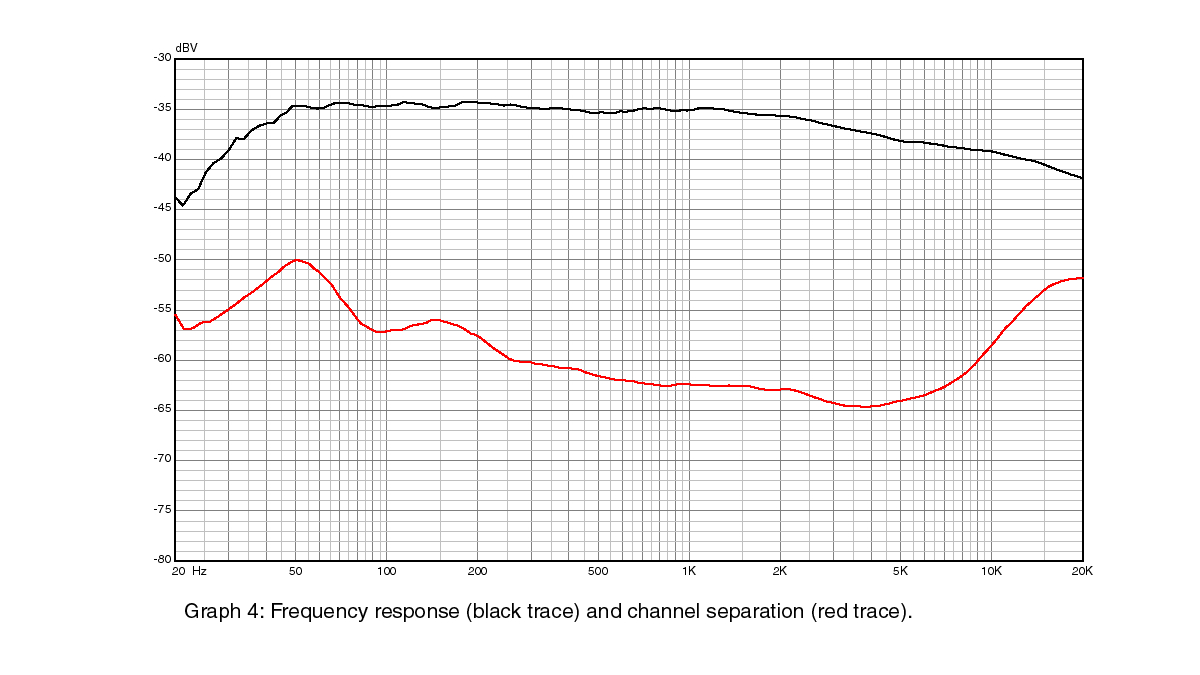
Newport Test Labs measured the frequency response of the Audio-Technica AT-VM95E phono cartridge as 25Hz to 20kHz ±3.5dB using a wideband pink noise signal, which is an excellent result.
However, as you can see from the black trace of Graph 4, the 3.5dB variations in the response were not spread equally across the audio spectrum, but are positioned in such as way as to emphasise the upper bass and midrange regions.
You can see that the response is 7dB down at 25Hz then rises quickly to 50Hz after which it’s very linear out to around 1.5kHz after which it rolls off very slowly and gradually to be 4dB down at 10kHz, 5.5dB down at 15kHz and 7dB down at 20kHz.
The red trace on Graph 4 shows channel separation vs. frequency and you can see that channel separation reaches a best result of 27dB at 1kHz (7dB better than specification), and maintains this level of performance out to around 6kHz before diminishing to around 20dB at 10kHz and down to 10dB at 20kHz.
It is worth noting that the frequency response and separation traces shown in Graph 4 are ‘worst-case’ figures because a pink noise test signal requires the phono cartridge to simultaneously produce all audio frequencies at the same time, which is obviously far more stressful than either music or by using a testing method that measures frequency response one frequency at a time (i.e., discrete or swept frequency measurements.)
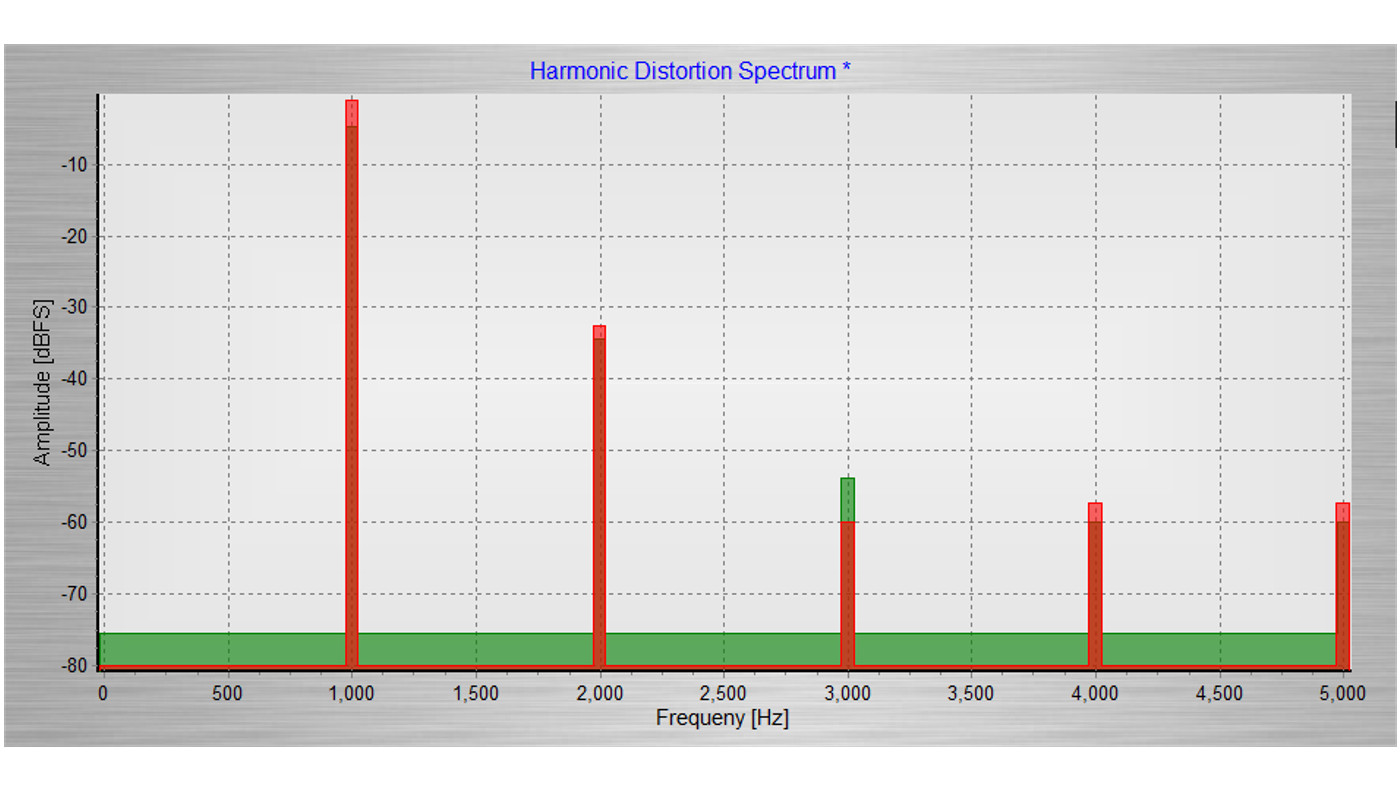
Phono cartridge distortion is shown in Graph 5 for a 1kHz test signal. You can see that second harmonic distortion is very slightly higher in the left (red bar) channel than the right (green bar), but both are sitting down at around –34dB (1.99% THD). Third harmonic distortion was a little higher in the right channel than the left, with the right channel coming in at –54dB (0.19% THD) and the left at –60dB (0.1% THD).
The fourth and fifth harmonic distortion components were around 60dB down for both left and right channels though, as you can see from the graph, distortion was very slightly higher in the left channel than the right. All these results are typical for a phono cartridge.
Newport Test Labs measured the voltage at the line output of the AT-LPW50PB as 157mV for a 1kHz test signal at a recorded velocity of 3.54cm per second, which is about that specified by Audio-Technica but appears lower simply because Audio-Technica uses a higher recorded velocity than Newport Test Labs (Audio-Technica’s specification is 200mV at 1 kHz at 5cm per second) when testing. It’s a good result.
Overall, both the Audio-Technica AT-LPW50PB turntable and the AT-VM95E phono cartridge returned excellent performance on Newport Test Labs’ test bench.
Australian Hi-Fi is one of What Hi-Fi?’s sister titles from Down Under and Australia’s longest-running and most successful hi-fi magazines, having been in continuous publication since 1969. Now edited by What Hi-Fi?'s Becky Roberts, every issue is packed with authoritative reviews of hi-fi equipment ranging from portables to state-of-the-art audiophile systems (and everything in between), information on new product launches, and ‘how-to’ articles to help you get the best quality sound for your home. Click here for more information about Australian Hi-Fi, including links to buy individual digital editions and details on how best to subscribe.
